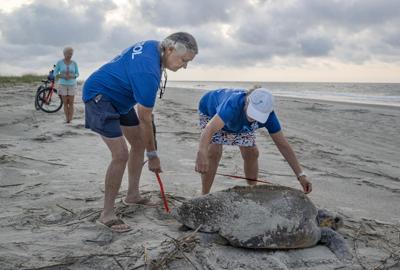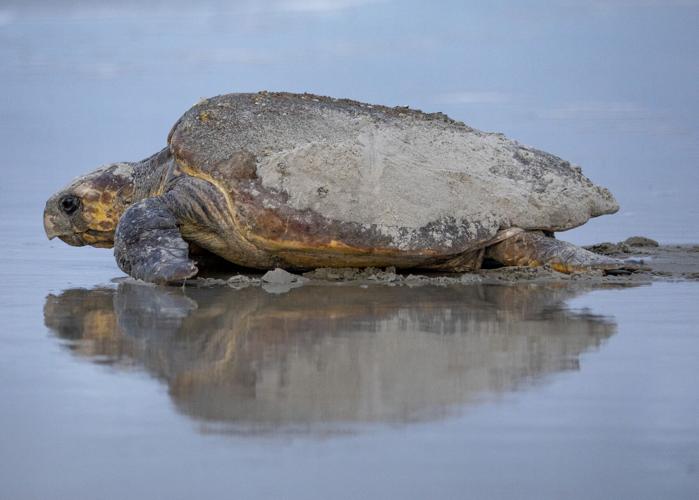
Nanci Polk-Weckhorst (left) and Mary Sheridan measure a mother loggerhead after she laid eggs before sunrise along the beach of Hilton Head on May 24, 2022. Loggerheads will lay nests a few times during the season and never return to the hatchlings. Andrew J. Whitaker/Staff
To spend the morning with the Sea Turtle Patrol is to undergo a master class not only in reptile habits, but in vocabulary.
What the patrol is looking for is a body pit, said group leader Amber Kuehn from the driver’s seat of a pick-up at dawn. That is the shape a sea turtle leaves in the sand.
“It’s like a turtle snow angel,” she said.

To the untrained eye, a loose oval of sand is indistinguishable from the rest of the beach, but Kuehn spotted one immediately.
The body pit meant that sometime in the night a female turtle lumbered out of the ocean, made her way to dry sand, dug a hole, released a clutch of eggs and covered up the nest.
Most likely it was a loggerhead. That’s the most common type around Hilton Head, although three other species of sea turtles have laid nests on the island. All seven species worldwide are endangered.

A mother loggerhead sea turtle crawls back into the ocean after laying 113 eggs in the dunes along the beach of Hilton Head on May 24, 2022. Andrew J. Whitaker/Staff
By Andrew Whitaker [email protected]
At the sight of the body pit, Kuehn slammed on the brakes, jumped out of the pick-up and inspected the turtle’s tracks — a pair of zig-zagging trenches like something heavy had been dragged on the shore. A female loggerhead weighs about 400 pounds.

Kuehn pointed to one of the flipper prints. “See how you can tell which direction the turtle was moving?” she asked.
The volunteers who accompanied Kuehn looked at her blankly.
Sighing, Kuehn drew an arrow in the sand. Incoming.
‘Today’ show talks up an already popular Hilton Head Island
Interpreting the incoming and outgoing tracks is important because it informs where the patrollers dig. They check every new body pit to confirm the turtle really laid eggs.
If she didn’t, the tracks represent what’s known as a false crawl. The turtle might’ve come ashore, hit too much natural debris on the beach — called wrack, Kuehn clarified — and returned to the sea.

If she did lay eggs, the patrollers make sure the nest is in a safe place. A few years ago, Kuehn drove the 14-mile length of the beach with a GPS identifying the line of the king tide — the highest tide. The patrollers ensure the nests are comfortably out of this zone, especially since it will be about two months before the eggs hatch.
If they discover a nest at risk of being disturbed, Kuehn and her crew will carefully move it.
Finding the eggs
On this morning, Kuehn was training two new volunteers — Cindy Wilson and Kathy Sanders — to uncover the eggs. To demonstrate how to probe the body pit she grabbed a wooden stick with a handle like a bike pump and stuck it into the sand. The idea is to poke around until the probe gives.
Kuehn hit the soft sand on the first try.
While a small crowd of early morning dog-walkers and beachcombers gathered, Wilson dropped to her knees and dusted off the sand around the probe. About six inches below the surface a glimmer of white peeked through, like a waxing moon: the day’s first egg. The onlookers cheered.

Public relations turns out to be a major part of the job for the Sea Turtle Patrol. Residents and visitors notice their silver truck and wander over to see what’s happening.
Kuehn, a marine biologist who also founded an eco-tour company called Spartina Marine Education Charters, would like to teach them about sea turtles. One of her repeated lessons: The sandy shores of Georgia, South Carolina and North Carolina are all one beach. Even though sea turtles return to their birthplaces to lay eggs, what that really means is that the female turtles coming to Hilton Head could have hatched anywhere in the tri-state area.
But most onlookers don’t particularly want to listen. They want to talk.
While chatty bystanders told her about the time they saw a loggerhead or how they spotted the tracks even before the Sea Turtle Patrol, Kuehn deftly guided them away from the nest. She has a word for this role, too. She’s a deflector.

A total of 113 eggs are moved to help protect them from king tides along the beach of Hilton Head on May 24, 2022. Andrew J. Whitaker/Staff
By Andrew Whitaker [email protected]
Digging a nest
Distracting the crowd was important because it allowed Wilson to count the eggs in the nest. One by one, she lifted 144 out of the sand and settled them gently into a plastic bucket. Kuehn determined they were too close to the water.
A little higher on the shore, Sanders looked for a place to relocate them.
When a mother turtle searches for a place to lay her eggs, she uses a sensitive spot under her chin to detect dry sand. Then she uses her back flippers, which Kuehn compares to mittens, to displace the sand. Making a nest takes about two hours, which is one reason she does it in the middle of the night — it’s too hot in the day for that kind of work, especially for a cold-blooded reptile.

But even warm-blooded mammals struggle. After only ten minutes of digging with a plastic scoop, Sanders squatted back on her heels, sweating and exhausted.
“Is that good?” she asked.
Kuehn came over and peered into the hole. She frowned. The chamber — the precise term for the interior of the nest – should be about two feet deep and in the shape of an upside down lightbulb.
After volunteers started informally keeping an eye on nests in the late 1970s, and officially organized in 1985, the number of hatchlings that made it to the water steadily increased. The vast majority were promptly eaten by predators. However, about 1 in 100 survived to spend their adolescence in the Canary Islands and the Azores, then return to the North American coast to reproduce.

A mother loggerhead sea turtle crawls back into the ocean after laying 113 eggs in the dunes along the beach of Hilton Head on Tuesday, May 24, 2022. Andrew J. Whitaker/Staff

Nanci Polk-Weckhorst (left) and Mary Sheridan measure a mother loggerhead after she laid eggs before sunrise along the beach of Hilton Head on Tuesday, May 24, 2022. Loggerheads will lay nests a few times during the season and never return to the hatchlings. Andrew J. Whitaker/Staff
A mother loggerhead sea turtle crawls back into the ocean after laying 113 eggs in the dunes along the beach of Hilton Head on Tuesday, May 24, 2022. Andrew J. Whitaker/Staff